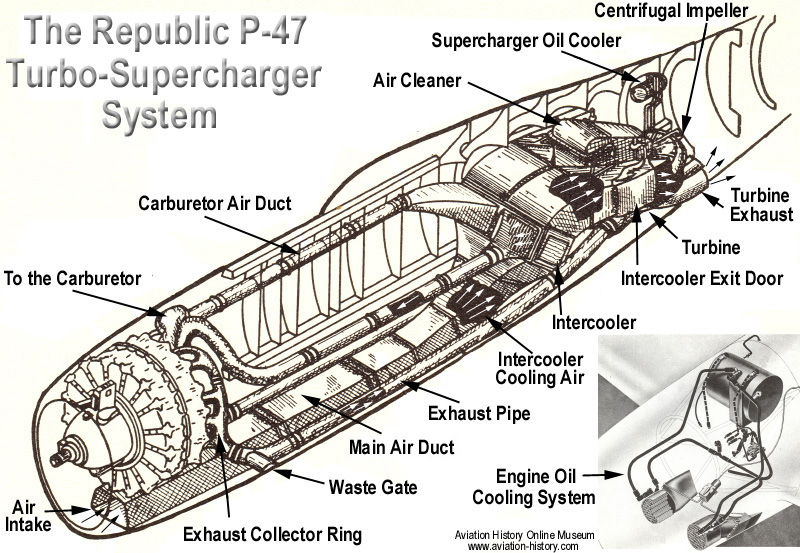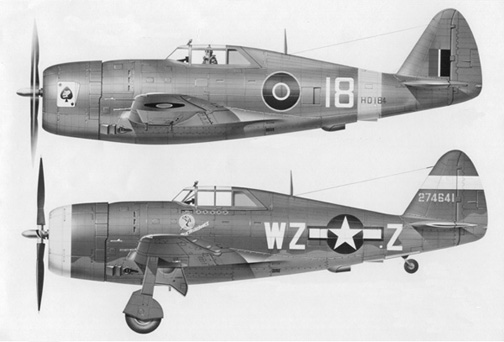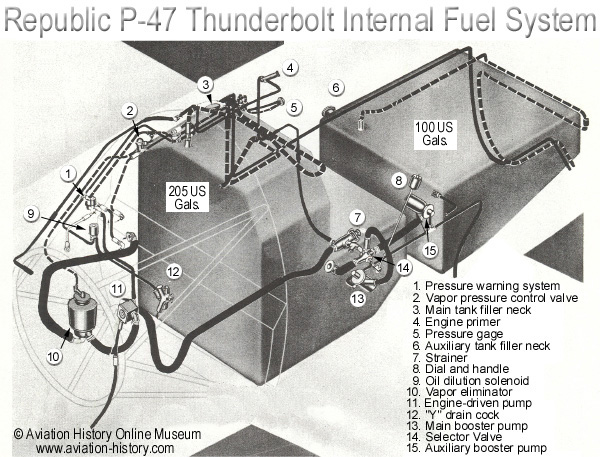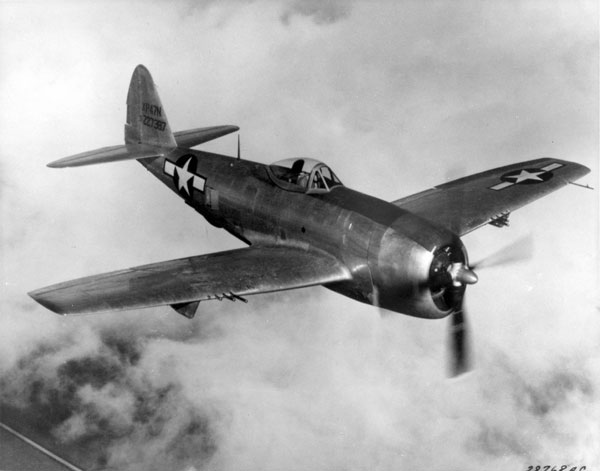The Republic P-47 was the successor of a line of airplanes derived from the Seversky P-35, the XP-41, P-43 Lancer and XP-44 Rocket. The P-47 design team headed by Alexander Kartveli, Republic Aircraft Corporations's chief engineer, originally presented a design that was to be powered by a 1,150 hp Allison V-1710-39 engine with an armament of only two 0.50 inch machine guns.1 A contract was awarded by the USAAC in November 1939, and for an even lighter XP-47A, but as intelligence was coming back from the war in Europe, it was becoming apparent that the performance goals of the XP-47 program were already inadequate. The USAAC issued new requirements which included:
1. Airspeed of 400 mph at 25,000 feet.
2. Armament of six .50 caliber machine guns, preferably eight.
3. Armor plating to protect the pilot.
4. Self sealing fuel tanks.
5. A minimum of 315 gallons of fuel.
The USAAC notified Kartveli that the XP-47A and the XP-44 Rocket contracts were canceled, since P-43/XP-44 airframe was to small to meet the new requirements. (The XP-44 Rocket was based on the P-43 Lancer airframe with a radial engine and never made it past the mock-up stage.) Kartveli then quickly prepared a rough sketch of a new XP-47B prototype, but it was a daring concept. He planned to use the new 2,000 hp Pratt & Whitney Double Wasp XR-2800-21, eighteen cylinder, two-row radial engine, which was the largest and most powerful aircraft engine ever developed in the United States.2 The new design would incorporate eight 0.50 inch machine guns, additional ammunition, increased fuel capacity and armor protection for the pilot. (The final fuel load was slightly under the capacity required, but this was overlooked as the aircraft met performance specifications.) Additionally the airplane would include an efficient super-charging duct system that would offer the least interrupted airflow. Kartveli therefore adopted the unorthodox method of designing this feature first, and then building up the fuselage around it. Despite the fact that the supercharger was in the tail and the engine was in the nose, the arrangement worked quite well—providing a system that was durable and less susceptible to battle damage.
 |
|---|
| The conventional three-bladed propeller could not efficiently utilize the power of the new engine, and a four-bladed propeller was adopted. Although this propeller was an admirable solution to the power gearing of the engine, there remained the problem of providing sufficient ground clearance for its 12-foot (3.66 m) diameter. If a conventional undercarriage were to be employed, its suspension would have been too far outboard to permit the wing installation of the guns, and ammunition requested by the USAAF. Therefore, Kartveli had to design a telescopic landing gear which was nine inches shorter retracted, than when extended. Numerous other problems were to be faced in absorbing the loads and stresses which would be imposed when a battery of eight 0.5-in. guns, (a phenomenal heavy armament for that time) were fired simultaneously, and in providing the necessary tankage for the quantities of fuel stipulated to make the machine the first true single-engined strategic fighter. |
 |
|---|
| The P-47D-15-RE Thunderbolt on top, was the first version to have underwing pylons to use droppable fuel tanks. Below is a P-47D-1 with white bands on the nose and tail to distinguish it from the Focke-Wulf Fw 190A. |
| The P-47B entered USAAF service in November 1942, becoming officially operational with the Eighth Air Force stationed in the UK on April 8,1943. However, the P-47B's range was not adequate for escort duties, and its maneuverability at low and medium altitude was poor. Since it was almost twice as heavy as it's opponents it exhibited a poor rate of climb, but had other advantages that more than compensated where it was lacking. In spite of its early shortcomings, the P-47 at least showed promise as a measure of real protection for Allied bombers, which had previously suffered very heavy losses. When, in January 1943, the USAAF's 56th Fighter Group arrived in the United Kingdom with its massive Republic P-47 Thunderbolts, RAF Spitfire fighter pilots banteringly suggested that their American colleagues would be able to take evasive action, when attacked by undoing their harnesses and dodging about the fuselages of their huge mounts. Although the Thunderbolt was certainly big, making it the largest and heaviest WWII single engined single-seat fighter ever built, its sheer size was not to prove detrimental to the Thunderbolt's subsequent operational career. The first tasks of the Thunderbolt were high-altitude escort duties and fighter sweeps, in which the new aircraft acquitted itself well, despite the inexperience of its pilots. It was soon discovered that the heavy Thunderbolt could out-dive any Luftwaffe fighter, or for that matter, any Allied fighter, providing a decisive method of breaking off combat when necessary, but at low and medium altitudes it could not match the rate of climb or maneuverability of German fighters. It's one main shortcoming was that of insufficient range to permit deep penetration into Germany, but means were already being sought to add to the P-47B's 305 US gallons of internal fuel. At the time of the Thunderbolt's European debut, radial-engined single-seat fighters were a rarity, the only other such fighter operational in Europe being the Focke-Wulf Fw 190A. To prevent confusion between the two fighters of the opposing sides, the engine cowlings of the Thunderbolts were painted white, and white bands were painted around the vertical and horizontal tail surfaces—an appropriate comment on recognition standards appertaining at that time, as it would seem impossible to mistake the sleek and beautifully-contoured German fighter for the portly Thunderbolt. |
 |
|---|
| By mid-1943 improved P-47Cs were becoming available, with external fuel tanks to increase range and a longer fuselage to improve maneuverability. The P-47D was the major production version of which 12,602 were produced. Early P-47Ds looked very much similar to the P-47C, but there were 21 variants of this model. 354 P-47Gs were built by Curtiss in Buffalo, and 130 P-47Ms were built with a 2,500 hp engine, giving a maximum speed of 473 mph (761 km/h). The P-47M version was used for anti V1 Flying Bomb duties. The final model, the P-47N, had extended wings and an additional 100 US gallons of fuel. It was developed too late to see much action in Europe and was primarily used in the Pacific theater. The fastest model was the XP-47J, which did not go into production. On August 4, 1944, this plane reached a level speed of 504 mph. Production plans were shelved in favor of another P-47 development, the Republic XP-72. P-47s flew more than 546,000 combat sorties between March 1943 and August 1945, destroying 11,874 enemy aircraft, some 9,000 locomotives, and about 6,000 armored vehicles and tanks. Only 0.7 per cent of the fighters of this type dispatched against the enemy were lost in combat. As a testament to the survivability of the P-47, it should be noted that the top ten aces who flew the P-47, returned home safely. Before the war was over, a total of 15,579 Thunderbolts were built, about two-thirds of which reached operational squadrons overseas. (www.aviation-history.com)Data of US Ace Pilots ETO (www.acepilots.com)
|
 |
| The final version, the P-47N, was built primarily for use against the Japanese in the Pacific theater. Shown is a XP-47N fitted with a bubble canopy. |




Tidak ada komentar:
Posting Komentar